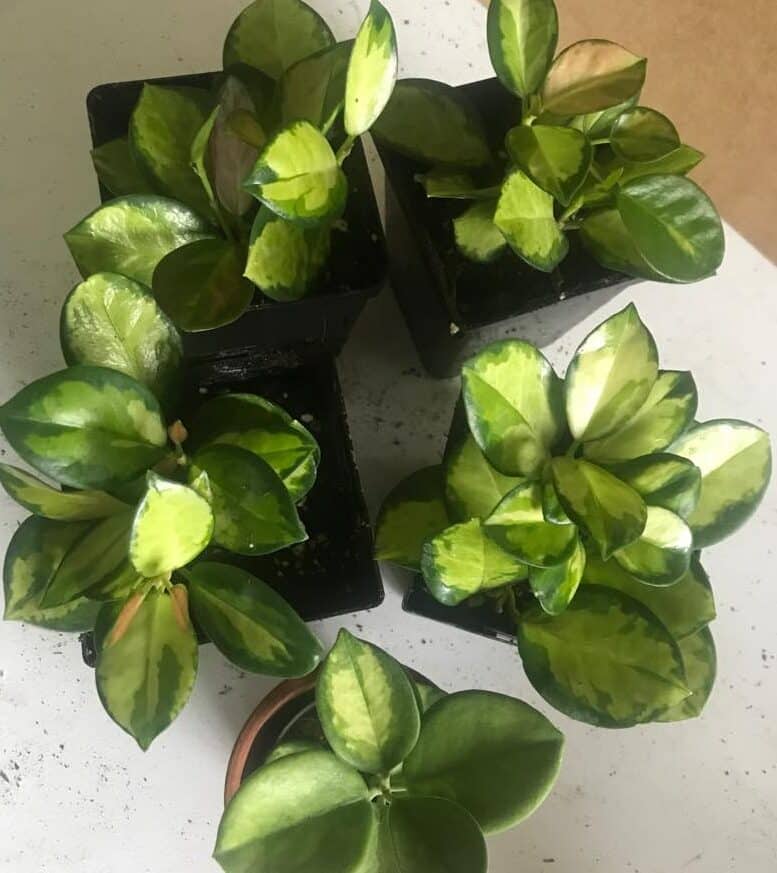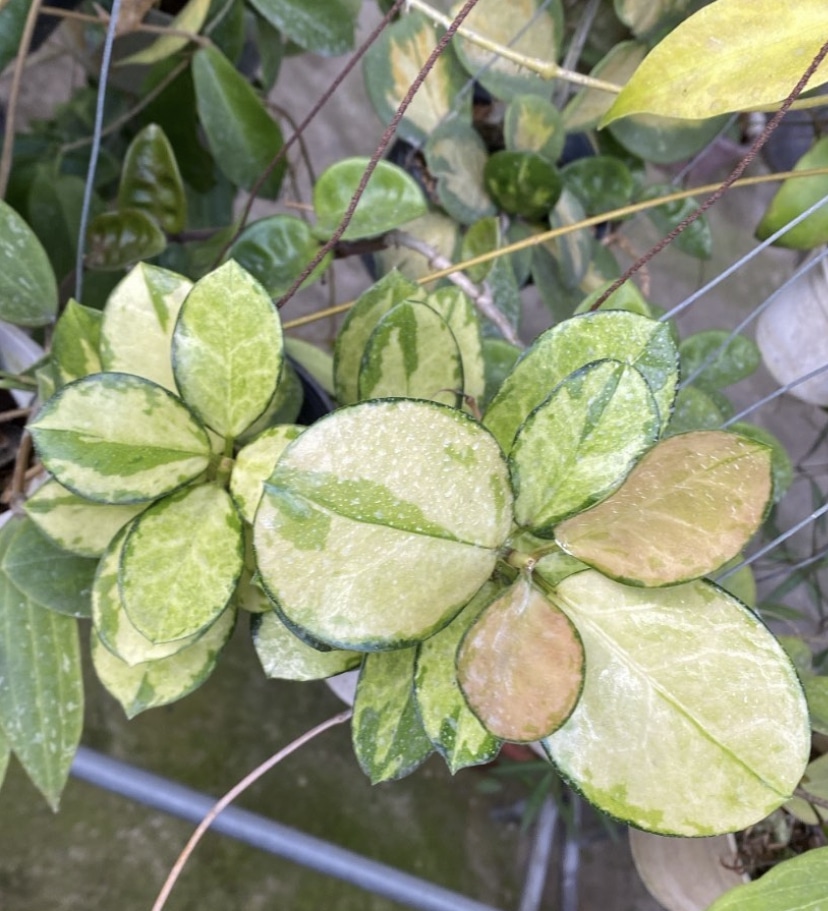Hoya Australis Lisa is a variegated variety of Hoya Australis, showing splashes of green and yellow leaves and waxy blossoms, but only if you keep the plant in tropical custody.
The article will give you all your answers regarding their care tips, problems, solutions, preventive measures, and ways to multiply them!
Table of Contents Show
Overview of Hoya Australis Lisa
Hoya Australis ‘Lisa’ is a variegated variety of Hoya australis flaunting yellow and green swatches on the leaves.
Most Hoyas are called ‘wax plants’ due to their glossy oval, alternately arranged leaves and gleaming flowers that bloom in groups.

The species ‘Australis’ was first spotted by European biologists in 1770 on the northern coast of Australia.
You might have already guessed where its species name ‘Australis’ comes from – obviously, its place of discovery.
Let us look more into the Hoya Australis Lisa.
| Feature(s) | Description(s) |
|---|---|
| Scientific Name | Hoya australis |
| Common Name | Wax Vine Common Wax Flower Samoan Wax Plant Hoya Lisa Wax Plant Lisa Variegated Hoya Australis |
| Family | Apocynaceae |
| Ecology | Life Cycle: Perennial Habit: Semi-Succulent Epiphytic Evergreen Climber Habitat: Tropical Forests and Dry Regions Native Range: Parts of South Eastern Asia and Northern, Eastern and Western Australia USDA Zones: 9b to 11 |
| Plant Size | 9 feet to 33 feet in length |
| Growth Rate | Moderate to Fast |
| Growing Seasons | Throughout Spring and Summer |
| Leaf | Shape: Ovate with Acute Tips Size: 6-7 centimeters long and 4.5 centimeters wide Color: Splash of Greenish-Yellow at the Center and Dark Green to Green Margins Texture: Glossy and Shiny |
| Flowering Seasons | Summer and Fall |
| Flower | Inflorescence: Umbel Shape: Semi-Globulous Bloom Cluster having Starry Flowers Color: White to Creamy White with Reddish- Pink Center (Corona) |
| Grown for | Variegated Leaves and White Flower Clusters |
| Toxicity | Mildly Poisonous to Humans Extremely Poisonous to Cats and Dogs |
Hoya Australis Lisa for Sale
Here is a list of portals to get Hoya Australis Lisa.
| Sites | Expected Delivery/Shipping Dates |
|---|---|
| In Succulent Love | Within 1-3 weeks after placing an order |
| Amazon | Within 4-5 days after placing an order |
Detail Look on Hoya Australis Lisa Care
Hoya Australis Lisa requires tropical conditions to thrive indoors.
This mellow plant has an easy care routine and tolerates subtle lighting, temperature, humidity, watering, fertilizer, and soil changes.

However, it’s essential to keep the plant pest, disease, and root bound-free by occasional pruning and repotting.
1. Light & Temperature
An occasional shift in the light source, location, intensity, and duration affects the surrounding temperature of the Hoya Lisa.
These vining climbers prefer the shady lower canopy areas under the tall trees in their natural turf.
So, try to manage light and temperature according to their liking.
Ups and dips in light and temperature can harm the leaves and flowers and cease their growth.

Extreme Light and Temperature Symptoms
- Waning leaf colors (yellow to brown)
- Brown crisp leaf tips and margins
- Leaf curling due to dry soil
- Wilting of leaves and stems
- Shrievling of roots
Low Light and Temperature Symptoms
- Yellowing and curling of leaves
- Drooping leaves followed by foliar dropouts
- Poor blooms and undersized young leaves
However, you can recover a stressed Hoya by managing its placement, light duration and intensity, and temperature changes.
Tips for Proper Ideal Light and Temperature
- Situate Hoyas near east-facing windows for morning or late afternoon sunlight.
- Locate the plant at least 3-5 feet away from south-facing windows.
- Use curtains to shield the plant from intense sunshine.
- Regulate the temperature by frequently misting the leaves during extreme heat spells.
- Cover the plant using a frost blanket in winter to prevent temperature drops below 55°F.
- Rotate the plant 90° every 1-4 weeks for even light distribution on the leaves.
- Keep the plant at least 6-12 inches far from artificial lights to provide 12/12 hours of light and dark periods.
2. Watering & Humidity
Although Hoya Lisa is a tropical plant, they have thick and slightly succulent leaves for retaining water.
They also love areas of high humidity and are drought tolerant but hate overwatering.
The plant cannot stand soggy soil. Its roots may rot if it sits in the waterlogged soil for a long.

Additionally, low humidity can suppress its growth and halt flowering.
Overwatering Symptoms
- Black and pulpy roots
- Mushy and foul-smelling soil
- Yellowing and rolling of the foliage
- Stooping stems, leaves, and vines
- Moist and brown spots on the leaves
Low Humidity Symptoms
- Poor production of leaves and blooms
- Stunted growth
- Dry soil and droopy foliage
Tips for Proper Water and Humidity
- Keep the overwatered plant under intense sunlight to dry up the soil.
- Toss the stagnant water from the pot plate after or before watering.
- Take moisture readings or check the top 1-3 inches of soil using a finger dip test between the watering sessions.
- Apply a bottom-up approach to saturate the soil or pot the plant in self-watering planters.
- Place the plant in a humidity tray or group the plants in a bathroom for optimum humidity.
3. Soil & Fertilizer
Hoya Australis Lisa requires a potting mix that drains water quickly and can hold nutrients.
The soil may lose all the minerals over continuous watering bouts, rendering the plant nutrient deficient.
If the soil is not well-draining, it occupies the tiny air pockets present in the soil, which chokes the roots and increases anaerobic activities in a lack of oxygen.
Moreover, the plant may suffer damage to the leaves and roots if you feed the plant during the dormant months of fall and winter.
Overfertilization Symptoms
- Brown and crisp leaf tips and margins (fertilizer burn)
- Accumulation of mineral salts on the topsoil
- Black and withered roots due to chemical burns
Under-fertilization Symptoms
- Progressive yellowing of the foliage
- Weak, undersized vines and leaves
- Reduction in blooming frequency
- Less number of flowers and leaves
- Purpling of the entire leaf or its areas
- Underdeveloped root system
To handle the fertilizer and soil demands, plan out a feeding routine and keep the potting environment as well-draining as possible.
Tips for Proper Fertilization and Soil
- Aerate the soil by mixing a good dose of organic perlite or place a layer of pebbles at the bottom of the planter before repotting.
- Perforate the topsoil to keep it fluffy, and use terracotta pots with drainage holes for sufficient percolation.
- Dilute the fertilizer to the required strength before application as instructed per pack.
- Remember to water the soil before feeding the plant for an even distribution of minerals within the soil layers.
- Flush out the excessive salts by washing the soil with distilled water 4-5 times monthly after the first application.
4. Biennial or Triennial Repotting
Hoya Australis Lisa is a slow to moderate grower.
As an epiphyte, its roots are delicate and modified to cling and take up moisture for the air.
Hence, the plant needs repotting only if it shows root-bounding signs.
Likewise, frequent repotting may affect the plant’s growth, damage the leaves, and even suffocate its roots.

Signs of Root Bound Hoya Lisa
- Roots protruding from the drainage holes
- Cramming of roots on the topsoil
- Coiling of the roots all over the root ball
- Quick drainage of water from the soil without any puddling
- Limpy and yellow leaves and stunted growth
Tips to Repot Hoya Australis Lisa
- Water your plant 1-2 days before repotting to loosen up the soil.
- Take out the soil from the sides of the pot and gently tug the plant out by grabbing its stem.
- Break the root ball inside a water bucket and free the tangled roots.
- Snip the unhealthy roots using sterilized pruners and keep the tan and fresh roots intact.
- Place a pebble layer at the bottom of a larger terracotta pot and fill it one-third with fresh soil.
- Hold the plant in the middle of the new pot and chug some soil from the sides to fill it up an inch below the pot’s brim.
- Afterward, water it thoroughly and leave it in a conducive environment for better adaptation.
The plant might show signs of stress immediately after re-potting due to transplant shock. But it will revive naturally after successful adaptation in a few weeks.
5. Annual Pruning
As the plant is a moderate grower, you need not prune Hoyas often.
Over time, the plant’s vines lank extensively and may need proper guidance to grow or a suitable groom.

Once the vines get unruly, pests and disease-causing pathogens may hide in the undergrowth and suck away all the juices from the plant.
Besides, pruning also enhances new healthy growth and helps solve the problem of stunted growth.
Thus, follow these steps to properly groom the plant and keep pests and diseases out of the bay.
- Using sterilized pruners, cut down the vines with yellow, brown, injured, or small-sized leaves.
- Snip the vines just above a node to inflict bushy growth.
- Deadhead the withered blooms, but keep the spur whole for flowering in the successive seasons.
- Avoid pruning more than one-third of the plant’s foliage at once.
- Use neem oil sprays to combat pests and diseases following infestations.
- You can also use a strong water spray to toss the pests from the lower surface of the leaves or around the vines.
Hoya Australis Lisa Toxicity
Hoya Australis Lisa is mildly toxic to humans but can be severe for pets, including cats.
Some subtle symptoms of ingestion may include stomach upsets, vomiting, and diarrhea.
So, you must wear gloves while pruning or repotting or keep the plant on a top shelf far from the reach of children and pets.
However, if the symptoms are drastic, register an emergency in the following hotlines for your children or pets.d
Growth Rate of Hoya Australis Lisa
The low-maintenance quality of Hoya Australis Lisa and its attractive variegated leaves and brilliant sweet-scented blooms make it a popular plant.
Since Hoyas are epiphytes, they grow on rocky rainforest surfaces and climb upward by holding themselves to neighboring trees.

Additionally, the plant is a moderate grower, climbing a few feet yearly, especially in spring and summer.
Since the plant is an evergreen perennial, it retains several variegated leaves growing alternately along the vines during its lifespan.
If the vines become shaggy, use a moss pole to help the plant climb higher and trail along a specified path.
However, before going dormant in winter, the plant produces clusters of creamy white to white flowers that last for a few days to a few weeks.
The flowers of Hoya smell like a mixture of Chocolate and Vanilla.
Later these flowers are replaced by an oval greenish-gray fruit bearing many seeds by early summer or fall.
Hoya Australis Lisa Propagation
You can replicate Hoyas using the stem or leaf cuttings from the mother plant in early spring or summer when the plant is actively growing.
Moreover, you can root the cuttings in the water and then put them in the soil after they develop healthy roots.
Furthermore, if you propagate them using cuttings, you will get an identical sister plant with the same features as your original plant.
Seeds are another way to grow new Hoya plants, but the process is sluggish.
1. Propagating Via Stem Cuttings
Here is a quick step to help you with stem propagation.
- Take a healthy 6-8 inches long cutting with 3-4 leaves right by snipping above the node at 45°.
- Remove the lower set of leaves to expose 2-3 nodes (leaf attachment point).
- Place the cuttings in a jar of distillate water amended with rooting hormone solution.
- Ensure that the nodes plunge below the water and the leaves remain out.
- Change the water every 2-5 days, and place the setup in dappling sunlight.
- After white and translucent roots sprout from the cut ends and get 1-2 inches long, transplant the cuttings in a fresh potting mix.

2. Propagation Via Leaf Cuttings
To propagate leaf cuttings, follow these simple steps.
- Select a healthy vine with a few leaves and pluck them out, but keep the petiole intact.
- Place the leaves with the petioles immersed in the hormonal water.
- Change the water when it gets murky, and keep the setup in dappled sunlight.
- Roots may sprout after a few days or weeks, after which you can plant them in the soil.
3. Transplanting in the Soil
Ensure using separate 6 inches-wide terracotta pots for the cuttings to prevent overcrowding.
Likewise, the potting process and aftercare routines for the stem and leaf cuttings are the same.
- Take a suitable planter, fill it with soil, and poke a hole at the center.
- Plant the rooted cuttings in the hole and cover their roots with the soil.
- Use a humidity dome or plastic wrap to secure humidity for the cuttings.
- Hydrate the topsoil when dry and nourish the cuttings at around 60-80°F.
- Locate them in bright indirect sunlight for 6 hours daily.
- Commence fertilizer application after they develop new leaves about 1-2 months following transplant.
- Continue the usual care from then on.

Follow the video to get a deeper insight into propagating the Hoya plant.
Hoya Australis Lisa Vs. Krimson Princess (Hoya Carnosa)
Hoya Australis Lisa and Hoya Krimson Princess are 2 varieties of 2 different Hoya species.
Lisa is a variety of Hoya Australis, and Krimson Princess is a variety of Hoya Carnosa.
They look almost identical, often creating a commotion in the gardening community.
However, the main difference between Hoya Australis Lisa and Hoya Krimson Princess is their leaves.
Lisa has comparatively round, thinner, and delicate leaves, and their young leaves have a red-pinkish tone that later turns green.
Similarly, the mature leaves have a central splash of lighter yellow variegation on light-green leaves.
In contrast, Krimson Princess has somewhat longer, thick, and waxy foliage. Likewise, they have darker green leaves and white variegation.
Moreover, the leaves of Crimson Princess (Hoya Carnosa Tricolor) have white, green, and pink variegations.
FAQs About Hoya Australis Lisa
Is Hoya Australis Lisa rare?
With its variegation on splashy green leaves, Hoya Lisa marks itself as a beautiful, rare, and uncommon plant to witness in the markets.
Why is my Hoya Australis Lisa not blooming?
Various factors might hinder the flowering of the Hoya Australis Lisa.
The most prominent issues are low light, untimely pruning, and lack of phosphorous.
From Editorial Team
Conclusions!
Provide ample bright indirect light, warm temperature, high humidity, and adequate watering.
Given proper care, the plant will reward you with its beauty and pleasing scent.


